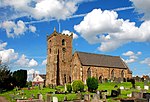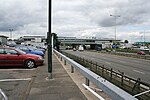Ratby railway station
1832 establishments in England1928 disestablishments in EnglandDisused railway stations in LeicestershireEast Midlands railway station stubsFormer London and North Western Railway stations ... and 7 more
Pages with no open date in Infobox stationRailway stations in Great Britain closed in 1873Railway stations in Great Britain closed in 1928Railway stations in Great Britain opened in 1832Railway stations in Great Britain opened in 1873Transport in LeicesterUse British English from May 2022

Ratby railway station served the village of Ratby, Leicestershire, England, from 1832 to 1928 on the Leicester and Swannington Railway.
Excerpt from the Wikipedia article Ratby railway station (License: CC BY-SA 3.0, Authors, Images).Ratby railway station
Station Road, Hinckley and Bosworth Ratby
Geographical coordinates (GPS) Address Nearby Places Show on map
Geographical coordinates (GPS)
| Latitude | Longitude |
|---|---|
| N 52.6439 ° | E -1.2368 ° |
Address
The Railway
Station Road 191
LE6 0JR Hinckley and Bosworth, Ratby
England, United Kingdom
Open on Google Maps








